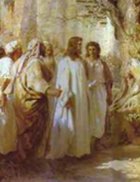The First Nicaean Council

.... Now let’s return to and finish our history lesson. For the first three hundred years after the ascension of Christ, the church was driven underground. In fact, there were ten imperial persecutions by the beginning of the fourth century. Communication was difficult but they were still trying to research a doctrine about the Godhead throughout that time.
.... In the fourth century, the Emperor Constantine came into power and claimed to be a Christian, which was in some ways debatable, but for the first in hundreds of years it created an opportunity for a church wide council. So in 325 A.D., Constantine called the church leaders together into a city called Nicaea, which is in present day Turkey. They came from all over the world to settle their problems, and especially their disputes about the Godhead.
.... Constantine himself attended the Council and this deserves a bit of historical elaboration. As church leaders gathered from around the world, Constantine, a recent convert to Christianity, was staggered at the sheer carnage of the broken lives around him. They appeared with missing limbs and other marks of torture that they had endured under persecution, such as huge wounds from bore holes where they had been augured with drills – yet they had remained steadfast to the faith, and had not denied the Lord. Constantine was so moved that he kissed their wounds and called them ‘noble confessors’.
.... I mention this because there is another sect today, known as ‘The Way International’, that has a very naive view to the contrary. They have been told that those Christians leaders were the ones in awe of Constantine, and threw out the ‘true’ Arian doctrines through political expediency in order to please their new emperor. As we shall see, this is anything but the truth! And by the way, they were also taught that the ‘Nicaean’ council met in Nice, France, and therefore it was dominated by Christians from the Western part of the empire – whereas the cradle of Christianity, and its better learning, was in the East. As a matter of fact the council included leaders from all over the empire, but if anything, it was vastly dominated by leaders from the east.
.... In this council, Christian leaders openly discussed the Scriptures pertaining to the Godhead. To their disappointment, Constantine had also invited Arius of Alexandria, who no longer held a position in the church but he was permitted to come before them to explain his doctrinal views. Through his arguments, out of over 300 bishops who attended the Council, Arius managed to convince only two of them – both Libyans like himself. Both he and they were excommunicated from the church by the rest of the Nicaean Council and labeled as ‘spoilers of the flock’; and twenty other bishops who had initially supported Arius, on hearing the views more fully explained, turned away from supporting him and ended up voting against him.
.... So the Nicaean council heard, tested, and rejected the Arian heresies, and took the first step toward recognizing the Doctrine of the Trinity instead. In fact they recognized that the Father and the Son were one, of the same substance and co-eternal, yet two distinct personages; they also took the first steps toward recognizing the Holy Spirit within the Godhead, though further research would follow on this point as the same claims about the Holy Spirit were fairly considered. This final step would be heard and fully accepted at the Council of Constantinople in 381 A.D., and afterward the Arian controversy virtually disappeared. So again, let’s review our doctrinal statement:
.... God is One in respect to essence; three in respect to personal distinctions, and three in regard to roles in the creative and redemptive process..... This has been sort of a background lesson, of history and doctrine, of what went into the Doctrine of the Trinity. In our next sections we’ll take a look at the Trinitarian concept itself and try to show the concept – three persons, yet only one God – in an understandable sort of way.
















0 Comments:
Post a Comment
<< Home